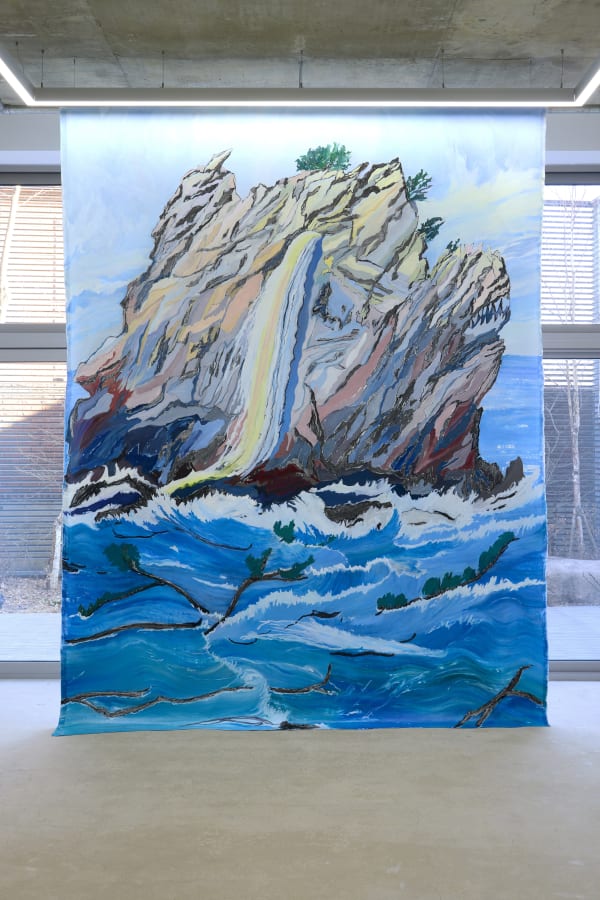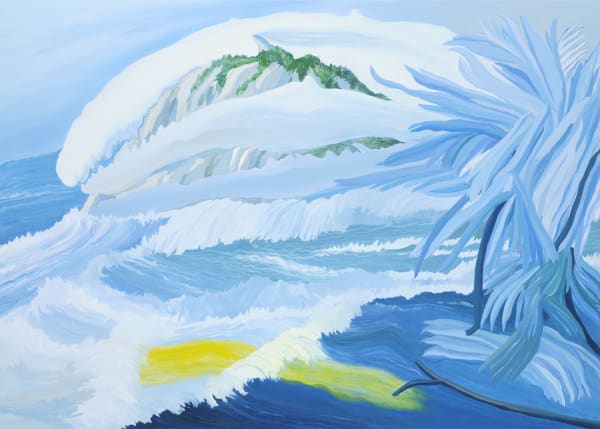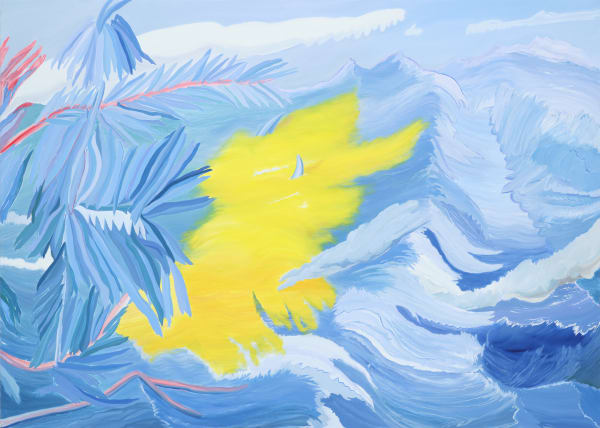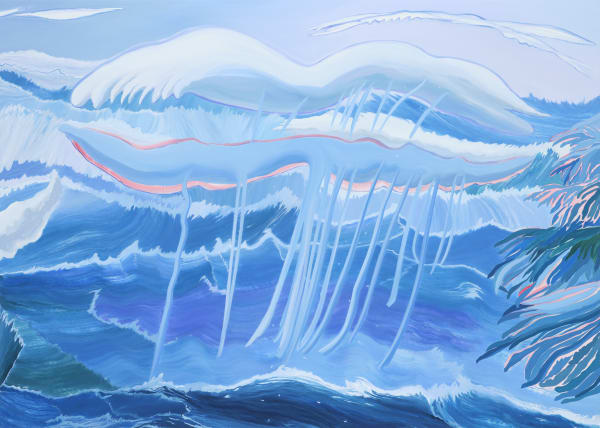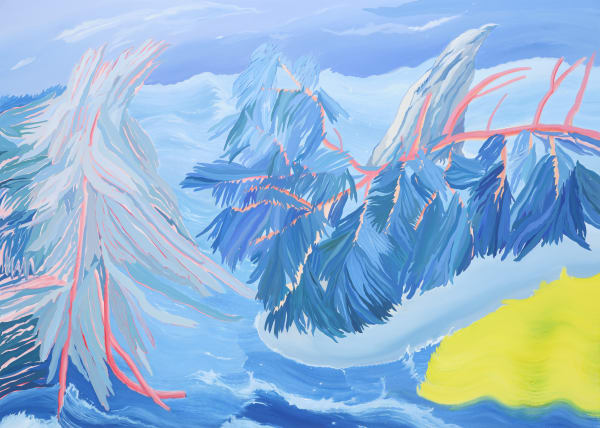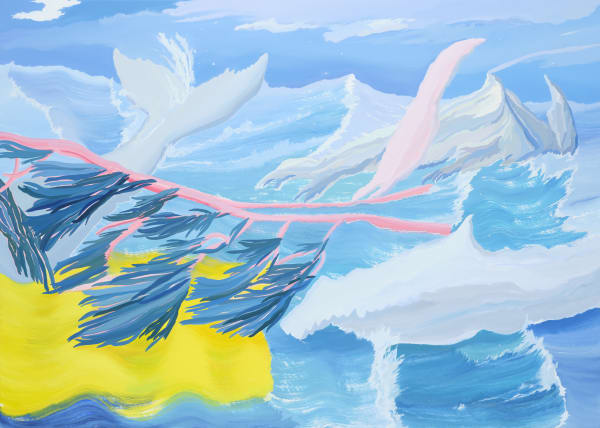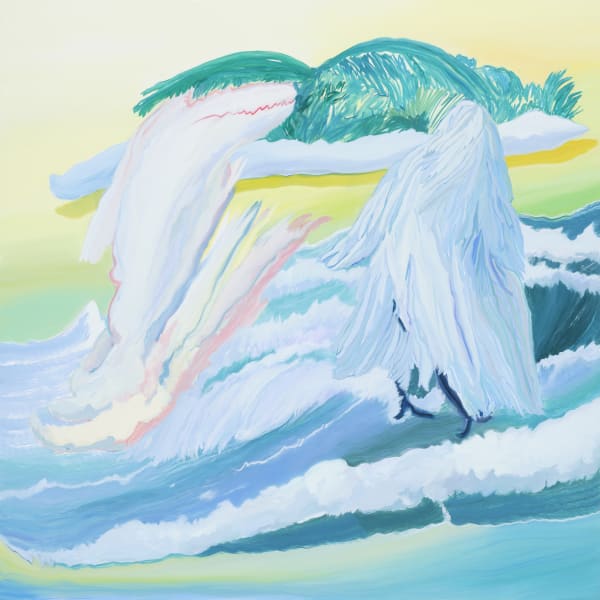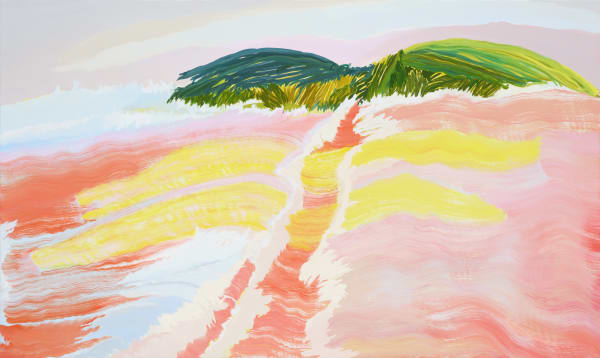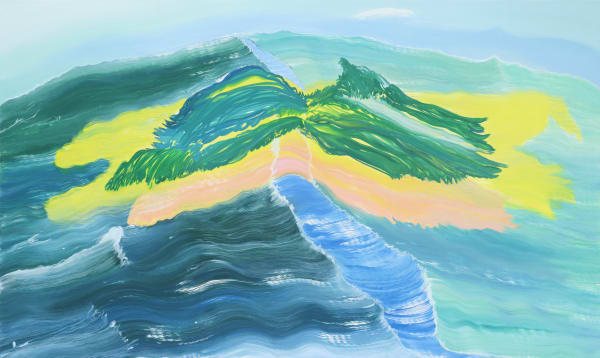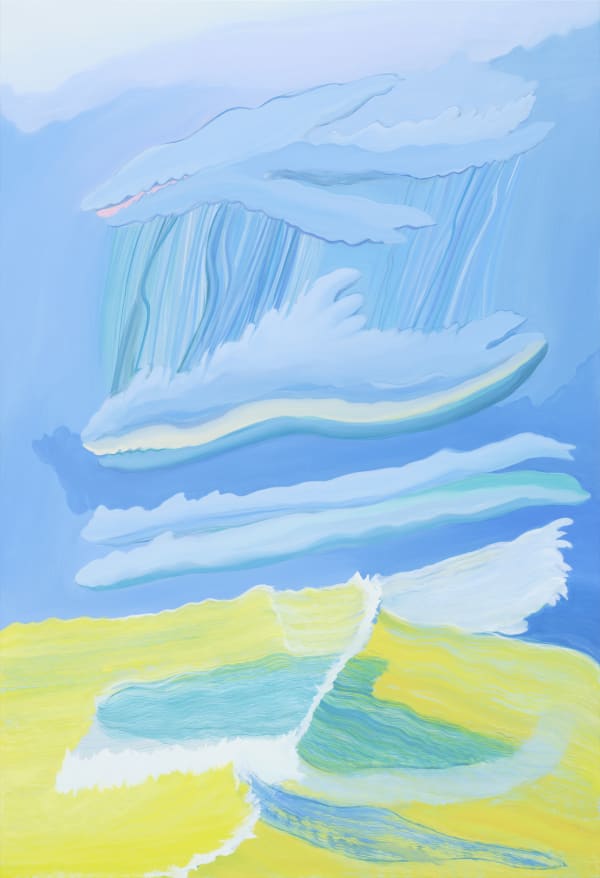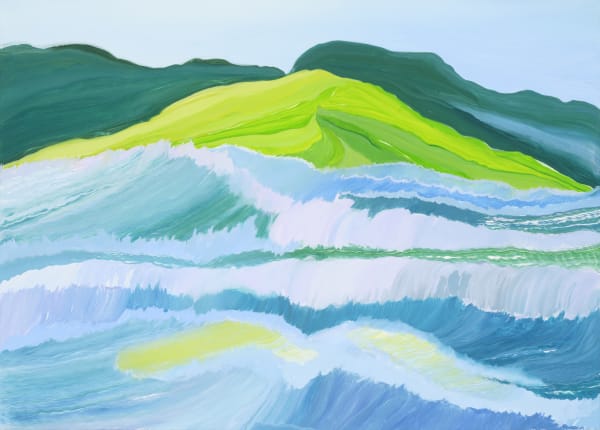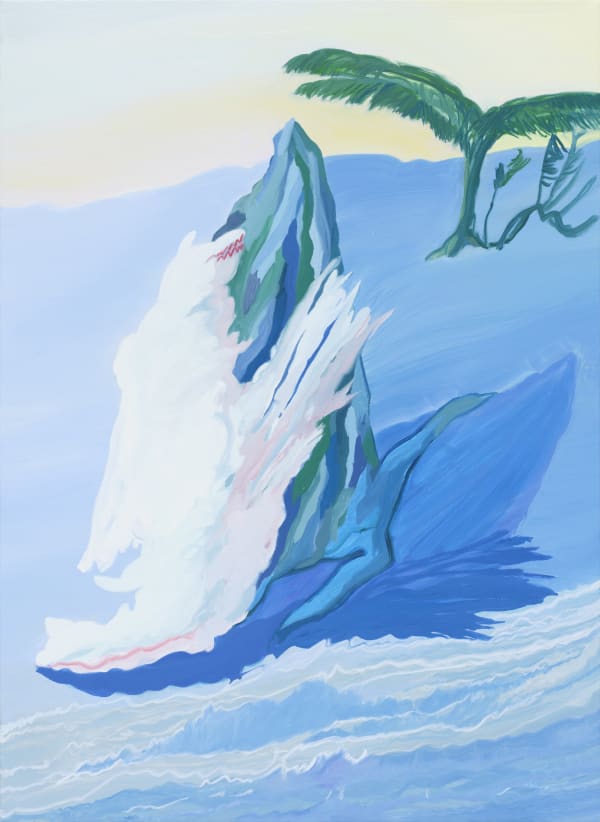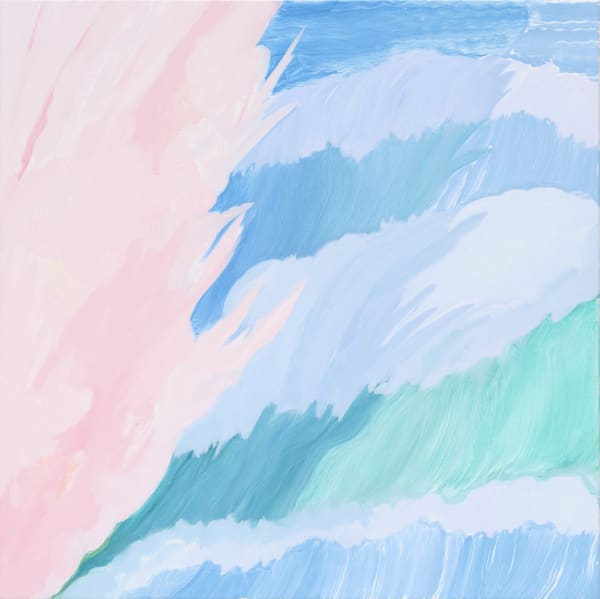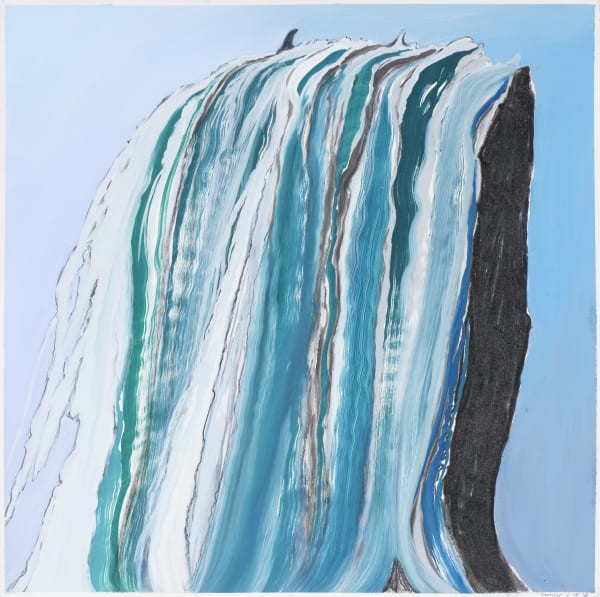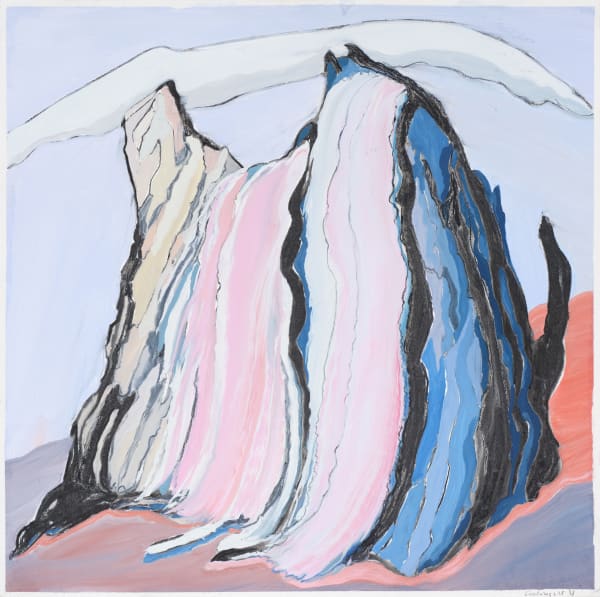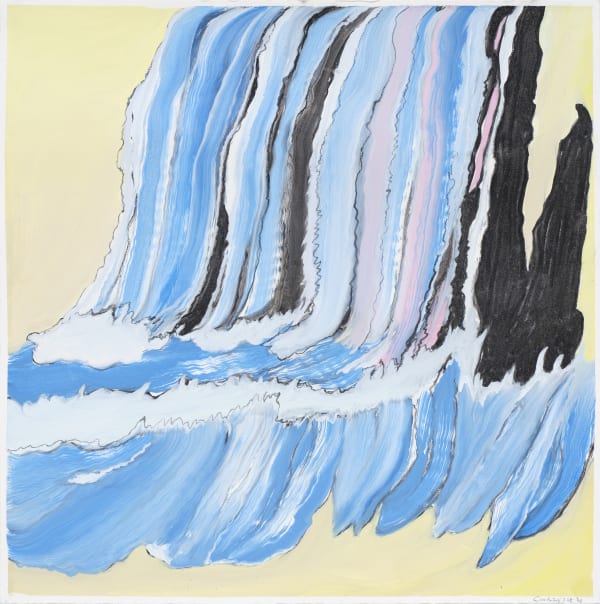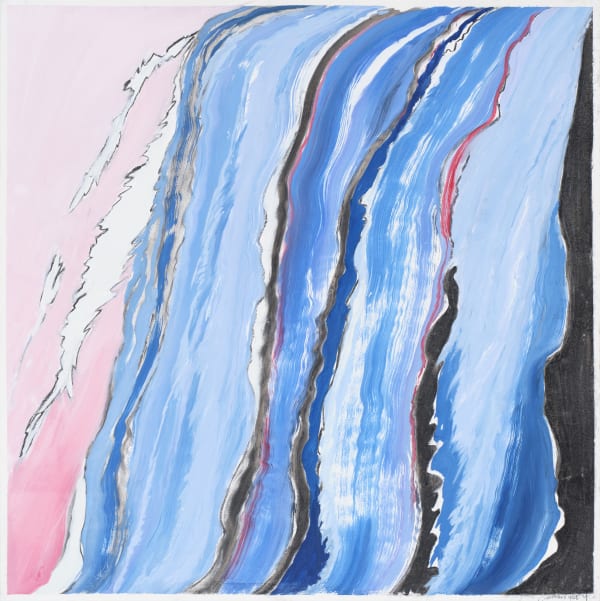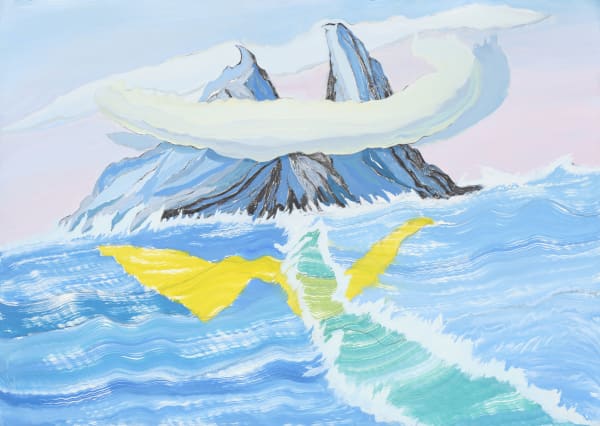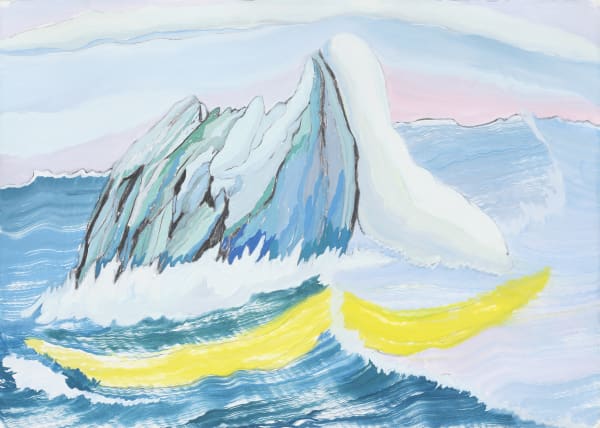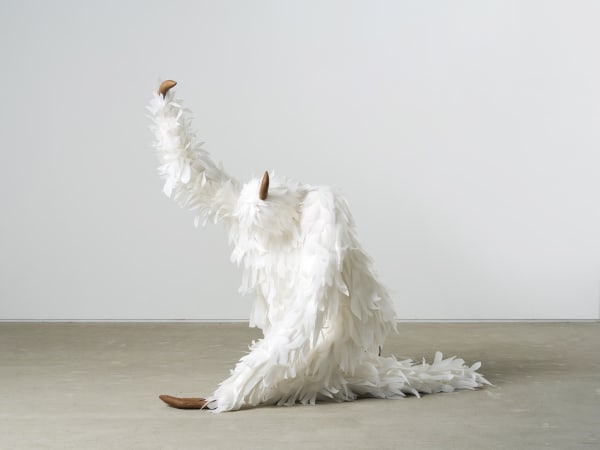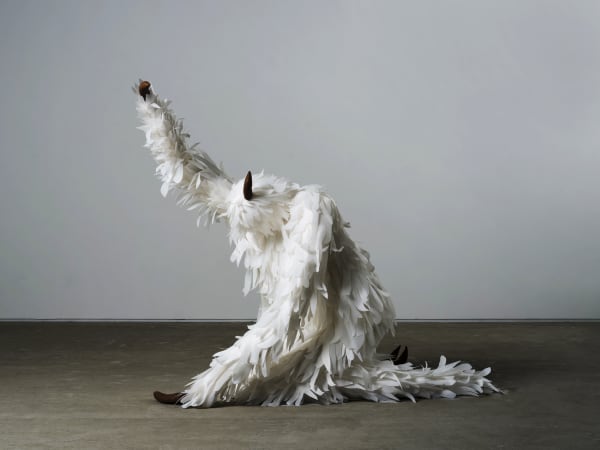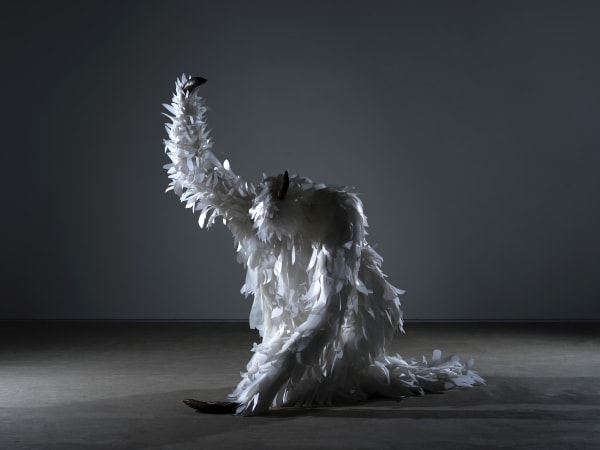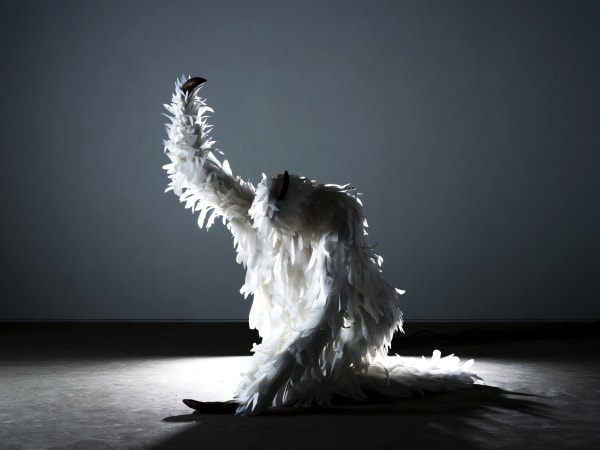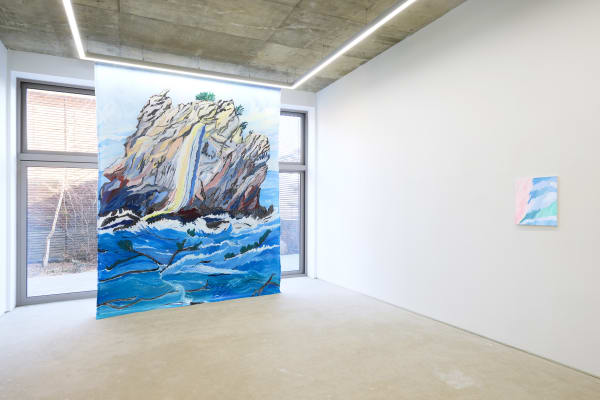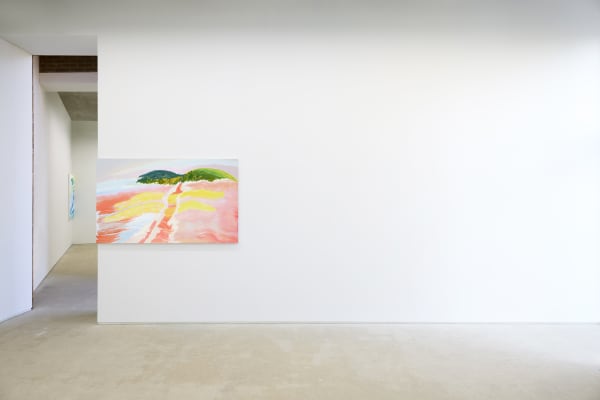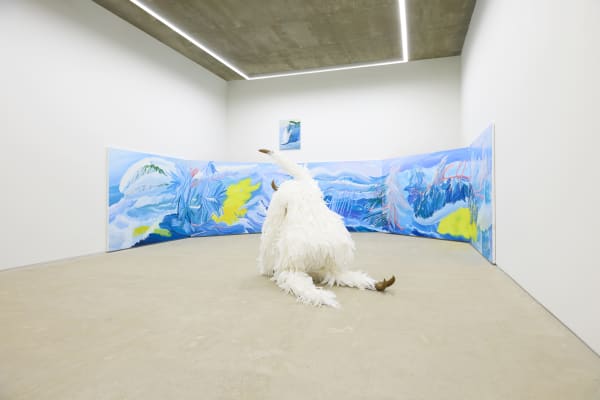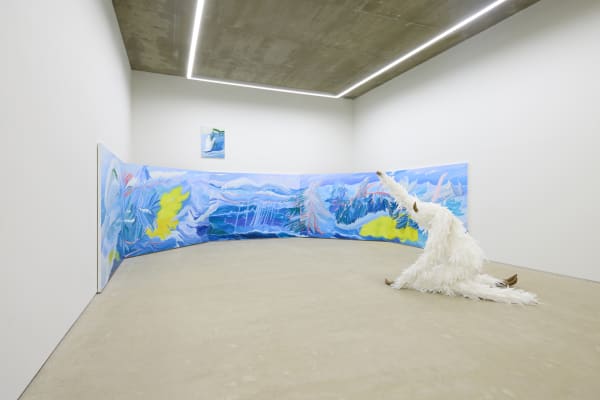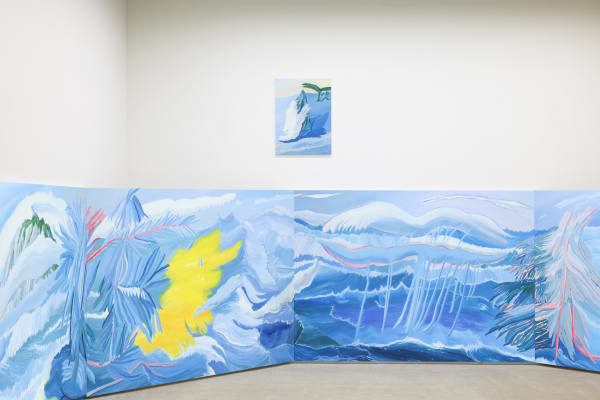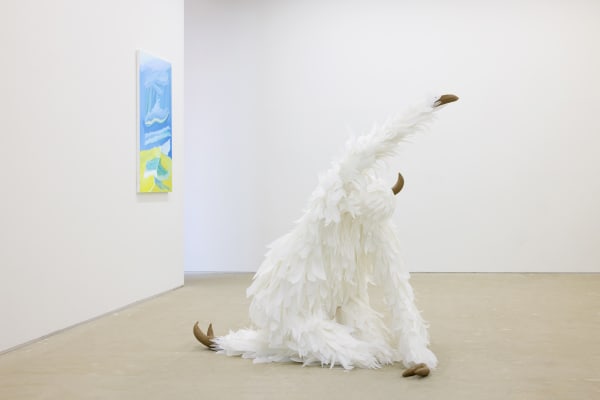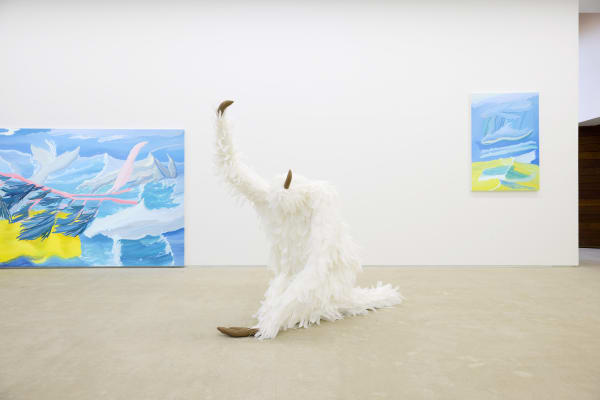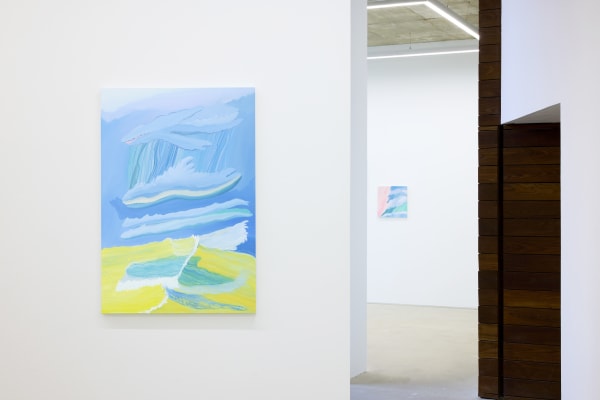들킨자 The Busted: 최수인 Suin choi
들킨자의 들추어진 감정은 이를 발견하고 언어화하는 외부인에 의해 말해진다. 여기서 외부인이란 최수인의 말에 따르면 관찰하는 자다. 그의 그림에 등장하는 들킨자는 타인과의 관계 속에서 이따금 불편해진 감정을 쥐고 사는 인물들이다. 정확히 말하면 그림에 그려진 것은 그렇게 형성된 내밀한 반응이 외면화 되어 형상으로 이행된 감정의 모양이다. 최수인의 개인전 《들킨자》는 많은 부분 연출로 상황화된 관계의 형성 방식을 고찰하며, 관찰자의 모습을 들킨자와 함께 등장시킨다. 그것이 이미지 내부가 아닌 외부에 투명하게 남아 있을지라도, 들킨 자와 그 주변에 공기처럼 섞인 관찰자의 모습은 대척점에 놓인 관계의 근원지들이 일궈내는 모종의 무대를 시각화한다.
무대란 단순히 시각적인 것에만 머무르지 않고 촉각, 후각, 공감각 등 여러 범위의 감각을 동시다발적으로 작동시키는 장치로서 유효하다. 회화의 시각성이 일반적인 무대의 역할로 기능적 확장을 시도하기는 어렵지만, 회화는 그것이 지닌 평평한 이미지를 바탕으로 무대와 ‘같은’ 상황을 연출하는 의미적인 효과를 발생시킬 수 있다. 〈내가 하는 말이 보이지 않나 보다〉(2025)는 최수인이 처음으로 시도한 연작 구성의 그림이다. 지금까지 그는 하나의 미장센을 토대로 단일 무대를 상상해 왔는데, 이번 작업은 5개 캔버스를 이어 붙여 파노라마형의 광활한 풍경을 새롭게 조성한다. 〈들킨자〉(2025)는 회화가 아닌 다른 매체를 다룬 첫 시도로, 조각을 활용한 입체적인 무대 구성에 접근한다. 커다란 휘장처럼 설치된 〈거북이 바위〉(2025)는 앞과 뒤를 바꿔 도치하듯 유리창 너머로 뒷면부터 보여주는 효과를 통해 이미지로의 진입 경로를 반전시키며 보편적인 감상 방식에 극적인 구조를 더한다.
잠시 그의 그림에 무엇이 등장하는지 살펴보자. 이곳에 놓인 여러 회화를 포함해 〈내가 하는 말이 보이지 않나 보다〉에는 푸른색 파도가 마구 치는 바다가 캔버스의 넓은 면을 차지한다. 특히 이 그림의 바다 위에는 약간의 남색을 더한 하늘이 펼쳐지며, 그곳이 바다가 있는 물질의 세계 뿐만 아니라 하늘까지 연장된 공간의 세계임을 암시한다. 삐죽삐죽한 나뭇잎과 가지를 솟아내는 나무들, 첨벙대는 파도 위 나뭇가지의 색을 닮은 주황-분홍빛 효과들이 이어진다. 나무는 어느 장면에서는 바람에 나부껴 꺾인 듯 하다가도 어떤 곳에서는 굳건히 자리를 지킨다. 이러한 자연물들은 꽤 자연스러우면서도 부자연스러운데, 전자의 이유는 으레 자연이라고 할 법한 공간에 누구나 볼 수 있는 요소들이 등장하기 때문이고, 후자의 이유는 그 모든 요소의 형태가 마치 특정한 근원적 유사성을 공유하듯 복슬 대고 뾰족하고 울렁이기 때문이다.
다시 그가 지속적으로 그려온 대상이 무엇인가에 관한 물음으로 돌아가서, 이처럼 대비되는 속성이 하나의 장면으로 모일 수 있었던 연유에는 그가 그리는 대상이 자연물 자체의 외형이 아니라, 타인과의 관계 속에서 형성되는 불편함의 감정, 그것을 들킨 인물의 감정 상태라는 그의 고찰에 있다. 그가 말하듯 아무렇지 않게 흘러가는 대화 가운데에는 자신도 모르게 울컥거리며 발동되는 감정이 존재한다. 이는 굳이 발설하고 싶지 않은 종류의, 어쩌면 숨기고 싶은 욕망을 발현시키는 이상한 징후다. 그는 그런 징후가 노출되지 않도록 자연물, 혹은 이름 모를 생명체가 털을 뒤집어쓴 듯이 방어적인 형태로 만들어 내고는 한다. 이로써 시각적인 자극에서 나아가 촉각적인 상상을 불러일으키는 이미지가 된 형태들은 결국 관객이 그의 이미지를 보는 방식을 경험의 차원으로 촉진한다.
한편, 그의 이러한 고찰은 《들킨자》의 구성에서 ‘관찰자’의 존재를 은유하고 암시하는 방식을 통해 복합적이면서도 다층적인 구조로 확장된다. 〈내가 하는 말이 보이지 않나 보다〉의 곳곳에는 자연의 형태라 할 수 없는 인위적인 노란색 형체가 그려져 있다. 이는 그가 상정하는 들킨 자의 형상으로, 인체나 동물과 같은 생명을 지닌 모양을 재현하지 않고 그저 외부의 누군가에 의해 들킨 것이 ‘있음’이라는 자취만을 남긴다. 〈들킨자〉는 무릎을 꿇고 앉아 한 팔을 든 인체에 가까운 형상이지만 정확히 무엇인지 단정할 수 없다는 사실에서 그것이 처한 상황, 달리 말해 보이지 않는 관찰자에 의해 자기 모습을 들켜버린 순간 자체를 묘사한다. 〈거북이 바위〉는 실제로 울릉도의 거북바위를 그린 것인데, 적당한 크기의 캔버스가 아닌 거대한 천막의 스케일로 커진 화면에 자연물과 자연물로 치환한 감정의 형태를 그림으로써 자신이 그림을 관찰할 뿐만 아니라 그림에 관찰을 당하는 역전된 관계를 체감하며 그려 나간 것이다. 목탄과 유화가 혼재된 화면은 손과 캔버스를 가까운 거리에 유지해 주는 드로잉의 제스처와 그 주변을 색과 점성으로 채우는 페인팅의 제스처를 뒤섞으며 화가와 대상의 유기적인 관계를 모색하게 한다.
관찰자가 누군가를 쳐다보는 눈과 마음은 이를 거리로 인식하는 자에 의해 외부로 경계 그어진다. 들킨자가 자신만의 내부라는 영역을 구축할 때 그는 언제나 외부인으로서 관찰자의 존재를 상상하고 말 테다. 이 관계의 무대 위에서, 《들킨자》는 더 들키고, 더 불편해하고, 더 숨으려 할 들킨자를 움직인다.
Choi Suin's solo exhibition "The Busted" explores the dynamics between emotions revealed in relationships and the gaze that captures these emotions. The underlying emotions of the exposed are articulated by outsiders who discover and verbalize them. Choi Suin states that the outsider is simply one who observes from the outside. The exposed figures in her paintings are characters who harbor the occasional discomfort in relationships with others; the paintings depict externalized and transformed visual representations of those uncomfortable feelings. The exhibition primarily examines how relationships are formed through staged situations, revealing the presence of the observer alongside the exposed. Even if this observer exists inertly outside the image, their very presence—pervasive like ambient air around the exposed figure—visualizes a kind of stage constructed by these antipodal origins.
In Choi Suin's work, this stage is a key mode of expression, operating not merely as a visual element but as a device that simultaneously stimulates multiple senses including tactile, olfactory, and synesthetic perceptions. While the visuality of painting cannot fully perform the multi-sensory role of an actual stage, it can generate semantic effects upon its flat surface and produce situations similar to a stage. In this exhibition, Choi expands these stage-like characteristics through three new approaches. You will not see it (2025) is the artist's first serial composition. While she has previously imagined a singular stage mise-en-scène, this latest work horizontally links five canvases to create a vast panoramic landscape. The Busted (2025) is her first work beyond the paint medium, a sculpture exploring three-dimensional stage composition. Turtle Rock (2025) is suspended like a large tapestry with the reverse side against the gallery's large front window, inverting the viewing approach and adding a new dramatic structure to traditional viewing methods.
You will not see itand other works in the exhibition feature raging waves upon a cobalt blue sea with slate, steel, and cerulean shades over large swaths of the canvas. Over the tempestuous waters unfolds a jagged horizon of a lighter sky, hinting of a space that extends beyond the agitated material world. Continued throughout are also trees with pointed leaves and sprouting branches, their orange-pink colors hinted over the waves. Trees appear bent by the wind in some scenes, while they stand firm in others. These elements of nature seem both natural and strange—as individual elements we would typically encounter in nature, while together they reveal a certain primordial resemblance—fluffy, pointed, and undulating in their billowing fractal similarity.
The reason such contrasting attributes could gather in a single scene lies in Choi Suin's contemplation of what she paints. It is not the exterior appearance of natural objects themselves, but rather the discomforting emotions from relationships—that is, in the sense of exposure, being found out. As she says, amid seemingly casual conversations, there exist emotions that burst forth, unexpected even to oneself. These are strange symptoms that expose desires one would rather not have made known, preferred to have kept hidden. In her work, these emotions are cloaked in protective guises—natural forms wrapped in fur-like textures—serving as defensive barriers against unwanted exposure. The forms, which now evoke tactile imagination beyond visual stimulation, ultimately usher the viewer's perception into the dimension of experience.
Meanwhile, her contemplation extends into a complex and multi-layered structure through methods that metaphorize and suggest the existence of the observer in the composition of "The Busted". Painted throughout You will not see it are unnatural yellow forms. These are her conceptualized figures of the exposed, lacking the shape of living beings or beasts and keeping only traces of something that was revealed to the external gaze. The Busted resembles a human figure kneeling with one arm raised, but a clear identification seems out of reach. This ambiguous posture captures the very moment of being found out by an invisible observer. Painted on an uncommonly large-scale surface, Turtle Rock is based on Geobukbawi (lit. turtle rock), a sea stack found on Ulleungdo Island, 120 kilometers east of the Korean Peninsula. Unlike the seaside formation, emotions translated into nature's forms were added upon the massive screen, effectively subverting the relationship between the subject and object of observation. Thus, the artist worked as the observer and the observed of her painting. The surface of Turtle Rock is a blend of charcoal and oil, of drawing and painting gestures. The former keeps the hand close to the canvas, while the latter fills all around it with color and density, beckoning the viewer to ponder the organic relationship between artist and subject.
The eyes and the mind of the observer are deemed external by those who observe it as distance. When the exposed figure constructs an inner realm, they are bound to forever imagine the observer as an outsider. On this stage of relationships, "The Busted" is an exhibition that moves the exposed, the very ones who will become even more exposed, more uncomfortable, and more intent on concealment.
